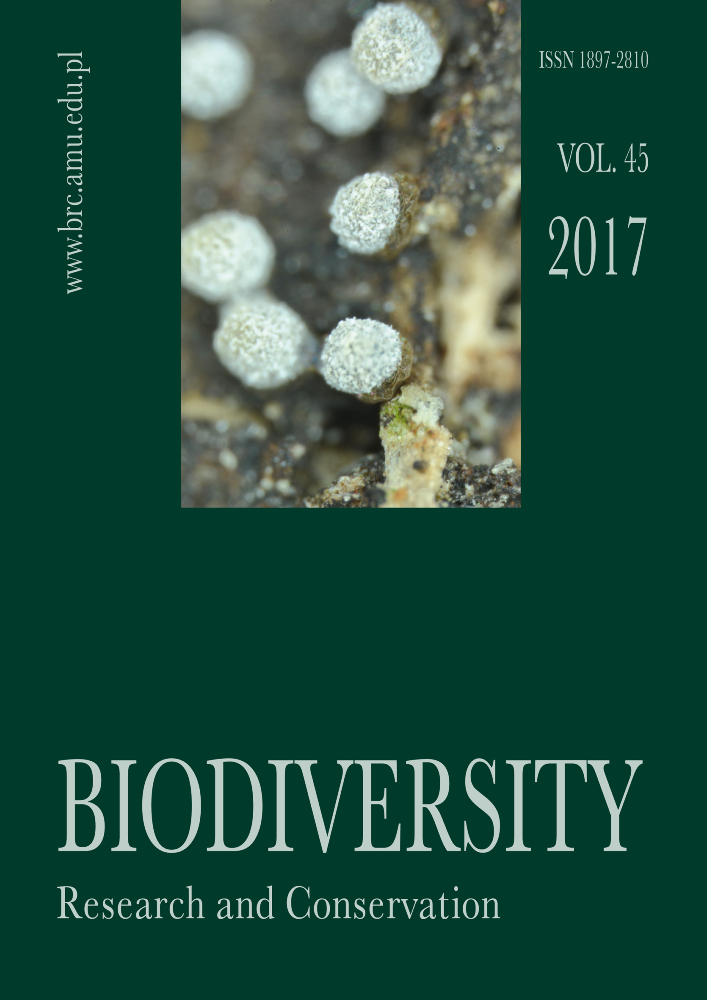Abstract
This study analyses the impacts of canopy disturbance on vegetation compositional attributes of two characteristic temperate forests (i.e., mixed broad-leaf and banj-oak forests) in west Himalayan part of India. Following the standard approaches, quantitative information on compositional attributes of forest vegetation was generated and analyzed. Considerable changes in these attributes were revealed across different levels of canopy disturbance in both forests. In particular, tree density and total basal area (TBA) exhibited significant decline from undegraded to degraded stands. Among others, seedling and sapling density of mixed broad-leaf forest was affected adversely by increased level of canopy disturbance. However, herb density in this forest increased significantly with increasing levels of disturbance; the same was not true for banj-oak forest. A significant decline in relative frequency and density of native herbaceous species was apparent towards degraded stands, implying that the disturbed sites in both forests created an opportunity for the establishment and proliferation of non-natives. However, with significant increase in relative density of non-native herbs, the degraded stands of banj-oak forest emerged as critically vulnerable to non-native proliferation. The patterns of tree size class distribution in both forests also exhibited certain trends across canopy disturbance, which suggested possible future changes in composition. In particular, the patterns of common tree associates (i.e., Myrica esculenta and Rhododendron arboreum) in banj-oak forest and Pinus roxburghii in mixed broad-leaf forest were indicative of likely compositional changes in near future. The study concludes that: (i) compositional attributes of both mixed broad-leaf and banj-oak forests were sensitive to increasing levels of canopy disturbance, (ii) mixed broad-leaf forest exhibited greater sensitivity to canopy disturbance at recruitment levels, (iii) increased canopy disturbance led to establishment and proliferation of non-native species in the herbaceous layer of both forests, and (iv) banj-oak forest exhibited high vulnerability to non-native proliferation at degraded stage.
References
Adhikari B. S., Rawat Y. S. & Singh S. P. 1995. Structure and function of high altitude forest of Central Himalaya. I-dry matter dynamics. Ann Bot 75: 237-248.
Baker H. C. 1986. Patterns of plant invasion in North America. In: H. A. Moony & J. A. Drake (eds.). Ecology of biological invasion of north America and Hawaii New York, pp. 45-57. Springer Verlag, Berlin.
Dhar U., Rawal R. S. & Samant S. S. 1997. Structural diversity and representativeness of forest vegetation in a protected area of Kumaun Himalaya, India: implications for conservation. Biodivers Conserv 6: 1045-1062.
Gairola S., Rawal R. S. & Dhar U. 2009. Patterns of litter fall and return of nutrients across anthropogenic disturbance gradients in three sub alpine forests of west Himalaya, India. J Forest Res 14(2): 73-80.
Gairola S., Rawal R. S. & Todaria N. P. 2008. Forest vegetation patterns along an altitudinal gradient in sub-alpine zone of west Himalaya, India. Afr. J. Plant Sci. 2(6): 42-48.
Gairola S., Rawal R. S. & Todaria N. P. 2015. Effect of anthropogenic disturbance on vegetation characteristics of sub-alpine forests in and around valley of flowers national park, a world heritage site of India. Trop Ecol 56(3): 357-365.
Kharkwal G. & Rawat Y. S. 2010. Structure and composition of vegetation in subtropical forest of Kumaun Himalaya. Afr. J. Plant Sci. 4(4): 116-121.
Kumar A. & Ram J. 2005. Anthropogenic disturbances and plant biodiversity in forests of Uttaranchal, central Himalaya. Biodivers Conserv 14: 309-331.
Misra R. 1968. Ecology workbook. 244 pp. Oxford and IBH Publication Co. New Delhi.
Mueller-Dombois D. & Ellenberg H. 1974. Aims and methods of vegetation ecology. 547 pp. John Wiley, New York and London.
Pandey U. & Singh J. S. 1984. Energy flow relationships between agro and forest ecosystems in Central Himalaya. Environ Conserv 11(1): 45-53.
Ram J., Kumar A. & Bhatt J. 2004. Plant diversity in six forest types of Uttaranchal, Central Himalaya, India. Curr Sci 86(7): 975-978.
Rawal R. S. 1991. Woody vegetation analysis along an elevationalgradient of upper surju catchment. Ph. D. Thesis Kumaun University, Nainital, India.
Rawal R. S., Gairola S. & Dhar U. 2012. Effects of disturbance intensities on vegetation patterns in oak forest of Kumaun, west Himalaya. J. Mt. Sci. 9(2): 157-165.
Rejmánek M. 1989. Invisibility of plant communities. In: J. A. Drake, H. A. Moony, F. di Castri, R. H. Groves, E. J. Kruger, M. Rejmánek & M. Williamson (eds.). Biological invasion: a global perspective, pp. 281-300. SCOPE 37: John Wiley & Sons, New York.
Shannon C. E. & Wiever W. 1963. The mathematical theory of communication. 117 pp. Urbana Univ. Illinois Press Urbana, III.
Singh J. S. & Singh S. P. 1987. Forest vegetation of the Himalaya. Bot Rev 53(1): 80-192.
Singh J. S. & Singh S. P. 1992. Forests of Himalaya: structure, functioning and impact of man. 249 pp. Gyanodaya Prakashan, Nainital, India,
Singh S. P. 1998. Chronic disturbance, a principal cause of environmental degradation in developing countries. Environ Conserv 25: 1-2.
Singh S. P., Adhikari B. S. & Zobel D. B. 1994. Biomass productivity, leaf longevity and forest structure in the central Himalaya. Ecol Monogr 64: 401-21.
Snedecor G. W. & Cochran W. G. 1969. Statistical methods. 593 pp. 6th edition Iowa State University Press. Ames Iowa, USA.
Uniyal P., Pokhriyal P., Dasgupta S., Bhatt B. & Todaria N. P. 2010. Plant diversity in two forest types along the disturbance gradient in Dewalgarh Watershed, Garhwal Himalaya. Curr Sci 98(7): 938-943.
Wilkum D. A. & Wali M. K. 1974. Analysis of a North Dakota gallery forest: vegetation in relation to topographic and soil gradients. Ecol Monogr 44: 441-464.
Wilkinson L. 1986. SYSTAT: The system for statistics. Evanston, IL: SYSTAT, Inc.




